Weekly Recap
The USD and U.S. stocks finished last week higher, with the S&P 500 booking its second straight weekly gain for the first time since January, and closing Friday with its 9th consecutive session in positive territory. Meanwhile, the tech-heavy NASDAQ rose 3.4%, boosted by better-than-expected earnings from several large-cap tech companies.
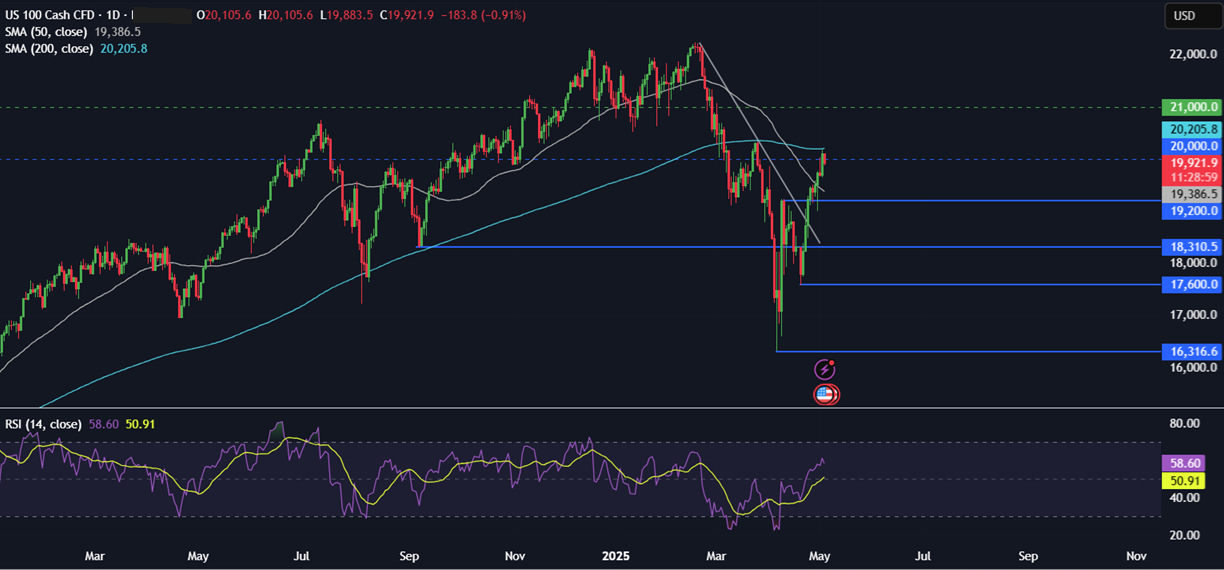
The positive sentiment was also driven by optimism around de-escalating trade tensions as President Trump rolled back some of his initial tariffs on cars and auto parts. Commerce Secretary Lutnik announced a historic trade deal crossing the line.
On the economic calendar, data painted a mixed picture with job openings falling to 7.2 million, its lowest reading since September last year. ADP payrolls dropped to 62,000; however, Friday’s non-farm payroll report surprised to the upside with 177,000 jobs in April, down slightly from March but well ahead of forecasts of 135,000. Despite an upbeat labour market, Q1 GDP showed an expected contraction of -0.3%, the first contraction since 2022, as the economy started to struggle even before Trump’s tariffs.
US-China trade war
Gold prices fell for a second straight week as the market mood improved, but are rising at the start of this week on worries over the trade outlook. Trump’s trade tariff developments will continue to drive the market. Signs of de-escalation in the US-China trade war could lower safe-haven gold and vice versa.
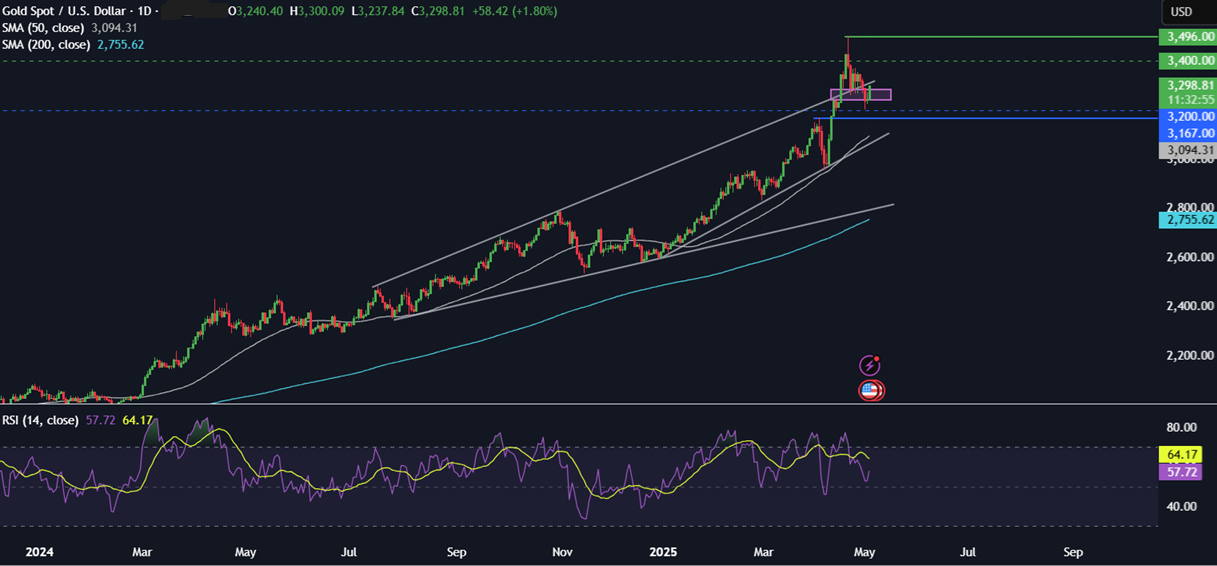
US ISM Services PMI (Monday)
Expectations are for ISM services PMI to ease slightly to 50.6 from 50.8, holding above the crucial 50 level that separates expansion from contraction. The data comes after the S&P Services PMI fell to a two-month low of 51.4 in April from 54.4 in March. The report noted that service sector activity growth slowed sharply to the second weakest in a year, due to softer orders and subdued new business inflows amid uncertainties over the economy and tariffs. The report also showed that service sector optimism dropped to its lowest level since October 2022, owing to the government’s policy and economic uncertainty. Weaker than forecast ISM services PMI could drag US stock indices such as the S&P500 lower and the USD lower.
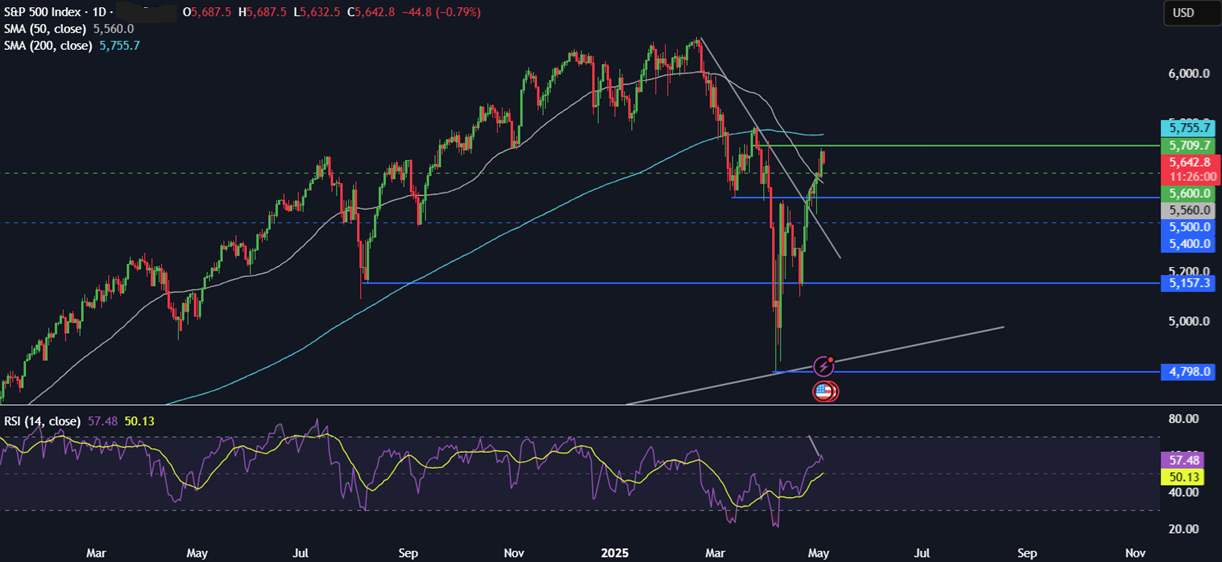
Chinese Caixin Services PMI (Tuesday)
The April Caixin service PMI will be released on Tuesday, following a modest pickup in March to 51.9. This month’s print will be monitored closely for signs of weakening momentum amid the escalating US-China trade war. Recent data has pointed to a deteriorating outlook. The official non-manufacturing PMI slipped to 50.4 in April, while the services sub-index also dropped. A similar softness could be seen in the Caixin PMI. Any further deterioration in the data could boost the case for more stimulus as Beijing faces growing pressure to support consumption and service sector growth. Stimulus hopes could boost AUD/USD, which is considered a proxy for China.
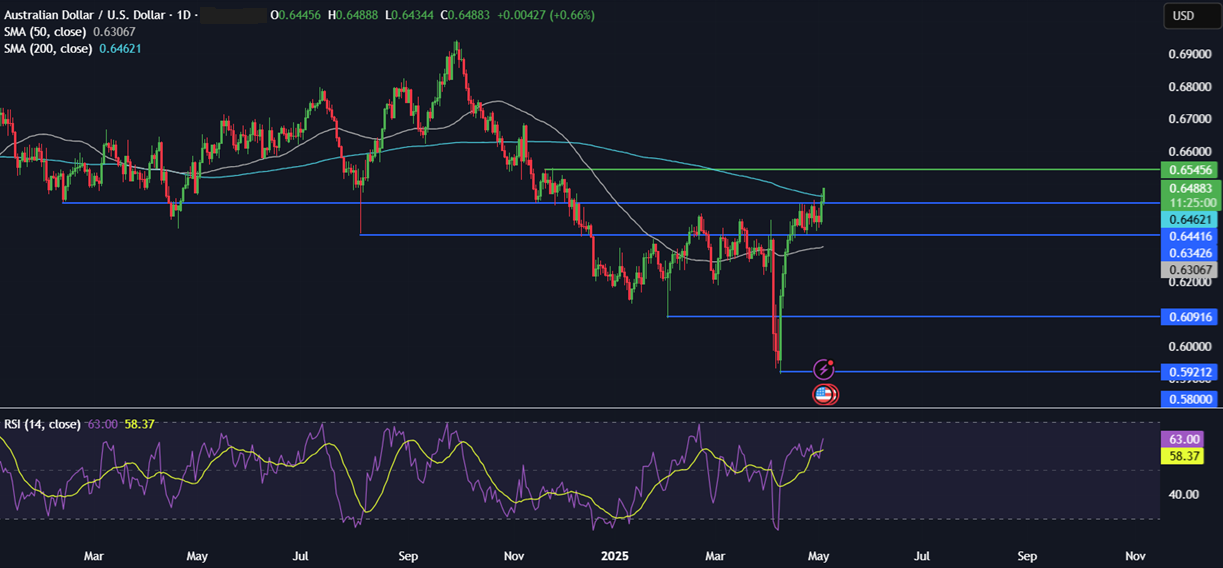
Fed rate decision (Wednesday)
The Fed will announce its interest rate decision on May 7 and is expected to leave interest rates unchanged at 4.25% -4.5%. As a result, the markets will be closely watching Federal Reserve chair Jerome Powell’s press conference for clues on how Trump’s trade policies could impact the central bank’s rate outlook.
Federal Reserve chair Jerome Powell and other Fed policymakers have signalled that short-term interest rates will remain unchanged as they wait for clearer signs that inflation is nearing the 2% target or if there is a whiff of a deteriorating jobs market. So far, neither of these is evident from the hard data following Trump’s import tariffs. However, it is still early days.
There is still much uncertainty over where policies will end up and the degree and timing of their impacts on inflation and jobs. Given the wide range of possibilities, the Feds will likely remain on the sidelines until there is more clarity. However, this hasn’t stopped the market from betting that a slowing economy will prompt the Fed to resume cuts by June and lower borrowing rates by 1% before the end of this year.
USD/JPY has recovered from its 2025 low. Should the Fed raise concerns over the US economic outlook, the pair could fall lower again. However, a more hawkish Fed could lift USD/JPY further.
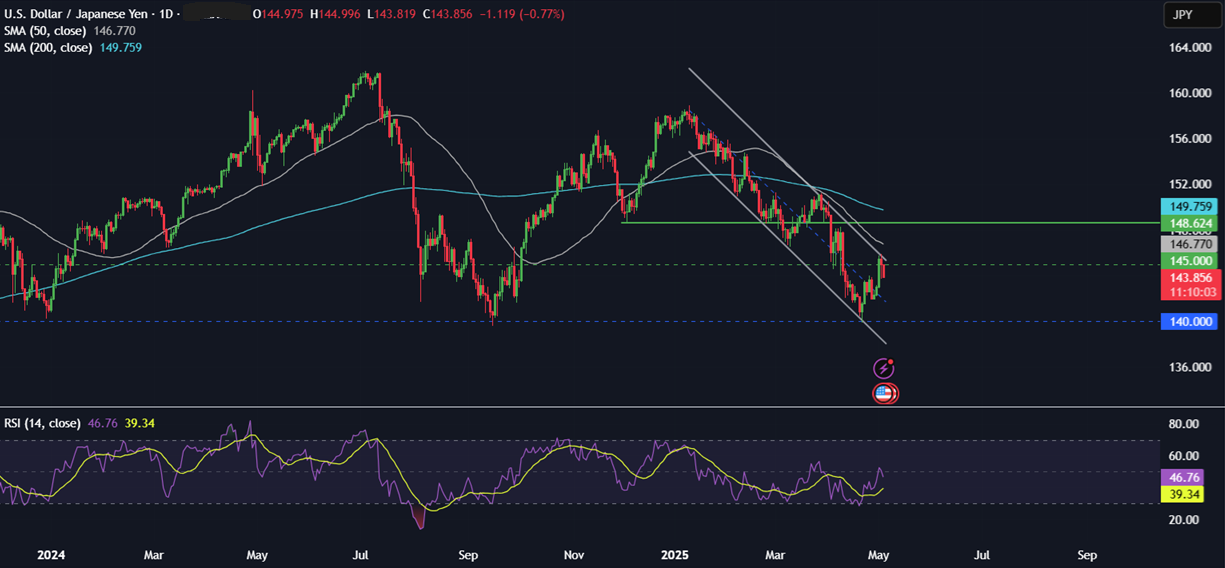
BoE rate decision (Thursday)
The Bank of England will announce its right decision on May 8, and the market is fully pricing in a 25 basis point rate cut. This will mark the 4th rare cut by the BoE since August last year, as the central bank has adopted a gradual and careful approach to easing monetary policy.
The markets had been pricing in 25 basis point cuts every quarter from the central bank, taking rates to 3.75% by the end of the year. However, the markets are now pricing in a terminal rate of 3.5% amid growing concerns over the impact of Trump’s trade tariffs on the global growth outlook. The IMF downgraded the UK’s growth forecast, and BoE governor Andrew Bailey warned that he was taking the risks posed by Trump’s trade tariffs very seriously.
Consumer inflation was lower than forecast at 2.6% in March but is still above the BoE’s 2% target and is expected to rise above 3% on higher energy tariffs in April. Meanwhile, annual wage growth is still near 6%, roughly double what the Bank of England considers to be consistent with 2% inflation.
However, even Megan Greene, a hawkish MPC member, said last week that she believes Trump’s trade tariffs could lower inflation.
A more dovish-sounding BoE could pull GBP/USD further from its 2025 high.
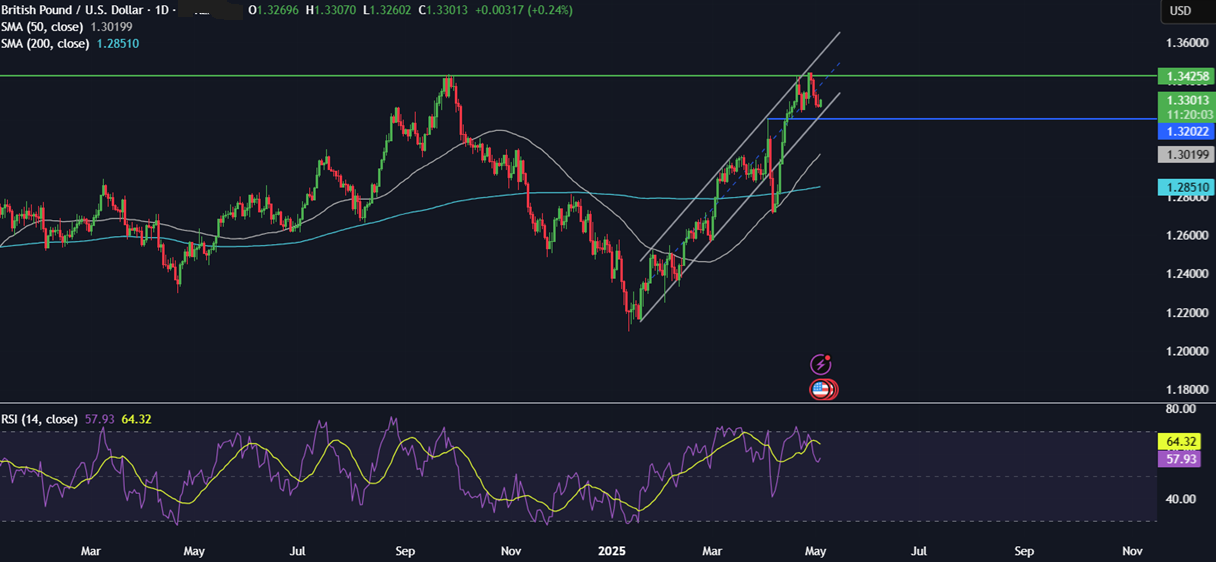
Canada Jobs Report (Friday)
The April jobs report will be monitored closely to see how the labour market is holding up in the wake of President Trump’s tariffs. The BoC expects the economy to slow in 2025 due to tariffs on exports to the US, uncertainty over trade policy, and a hit to consumer sentiment. Policy makers also noted in the meeting minutes how the recovery in the labour market, which began in late 2024, appears to have stalled as trade tensions escalated. A recent survey by the BoC also indicated that businesses were scaling back hiring owing to the uncertainty.
The BoC left rates unchanged in its last decision. However, a deteriorating labour market could lift the case for further rate cuts. There is still a significant amount of uncertainty surrounding U.S. trade policies and their impact on the Canadian economy. Weak jobs data could pull the loonie lower, while stronger jobs data could help the CAD rise.
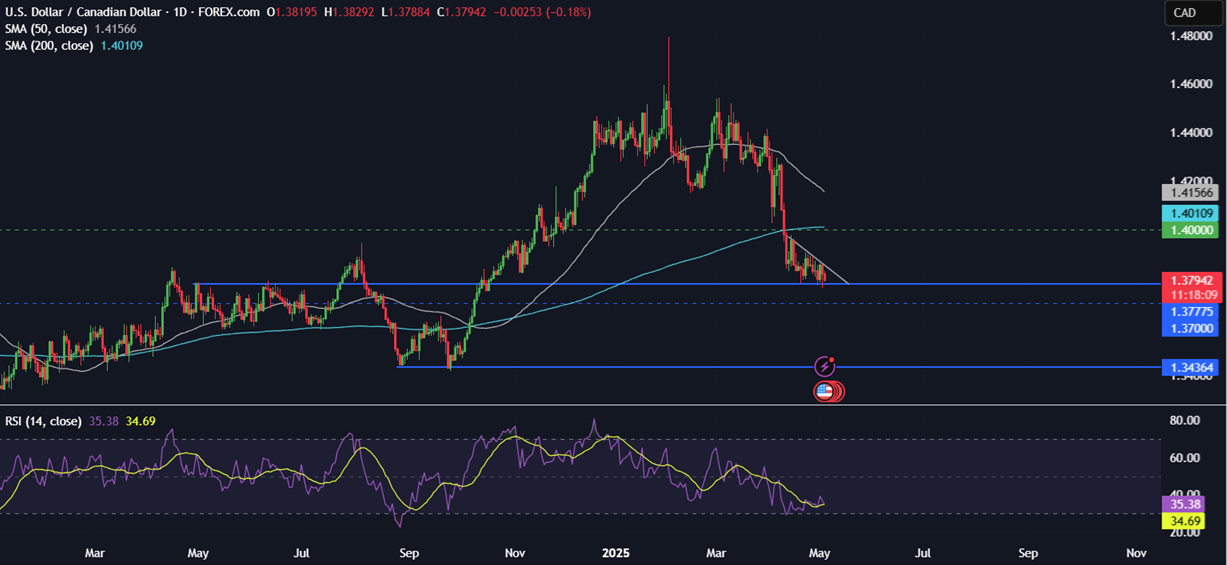
Trading involves risk.
The content provided here is for informational purposes only. It is not intended as personal investment advice and does not constitute a solicitation or invitation to engage in any financial transactions, investments, or related activities. Past performance is not a reliable indicator of future results.
The financial products offered by the Company are complex and come with a high risk of losing money rapidly due to leverage. These products may not be suitable for all investors. Before engaging, you should consider whether you understand how these leveraged products work and whether you can afford the high risk of losing your money.
The Company does not accept clients from the Restricted Jurisdictions as indicated in our website/ T&C. Some services or products may not be available in your jurisdiction.
The applicable legal entity and its respective products and services depend on the client’s country of residence and the entity with which the client has established a contractual relationship during registration.




